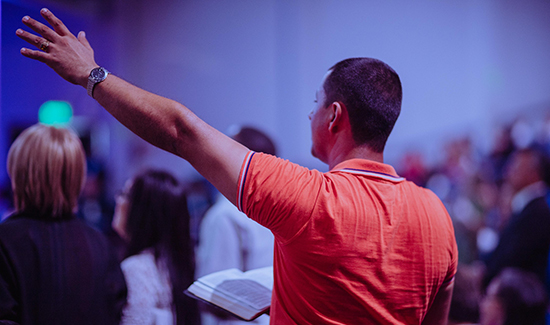Why Praying "God, Bring Young People Back to our Church" is Not Enough
How can a church with an older congregation attract young people? The following keys sparked a revitalization and growth that turned a “dying church” into a “thriving church.” | by Lee Kricher
Did you watch at least one movie in the last month? If so, did you rent that movie at a Blockbuster outlet? Chances are, the answer is no. In 2004, there were over 9,000 Blockbuster outlets. Today there is only one in the entire United States.
There was a time when I used to go to Blockbuster at least once a week. It was convenient because it was next to the Fotomat where I got my pictures developed. Blockbuster outlets didn’t close their doors because people stopped watching movies. Blockbuster closed their doors because they failed to be as innovative in their approach as others in the entertainment industry.
In the same way, your church will not become an aging, declining church because the next generation is not open to the hope found in Jesus Christ. However, your church may become an aging, declining church if you fail to be innovative in your church’s approach to introducing the next generation to the hope found in Jesus Christ.
The Fastest-Dying Church in Town
In 2003, our church was ready to close its doors. We had experienced several years of declining attendance, and the average age of our church attendees was well over 50 years old — more than 15 years older than the average age of the community in which we were located. We were considered by many to be the fastest-dying church in town.
Prayer was not the issue. We had many sincere people who were praying, “God, bring young people back to our church.” Unfortunately, there was an unspoken additional sentence added to those prayers: “God, bring young people back to our church…without us needing to change.”
It is common for church members to assume that programs, ministries and practices that were effective in the past should continue indefinitely into the future. In his book Autopsy of a Deceased Church, Thom S. Rainer writes about churches he studied that have ceased to exist:
The most pervasive and common thread of our autopsies was that the deceased churches lived for a long time with the past as hero. They held on more tightly with each progressive year. They often clung to things of the past with desperation and fear. And when any internal or external force tried to change the past, they responded with anger and resolution: “We will die before we change.” And they did.
The people who Tom Rainer studied are not heroes who refused to compromise the life-changing message of Jesus Christ. They were people in love with the past who refused to consider innovative approaches to church in a rapidly changing world. One wise business leader said that “When the changes on the outside of your organization are taking place more quickly than the changes inside, the end is in sight.” That is true for any organization. That is true for any church.
A Willingness to Change
During a several-year period when I was not in full-time ministry, I was fortunate to have worked for two prominent consulting firms that were known for their change leadership expertise. I came to understand a core truth about change leadership that is described well by Jim Collins and Jerry I. Porras in their book, Built to Last:
Contrary to popular wisdom, the proper first response to a changing world is not to ask, “How should we change?” but rather to ask, “What do we stand for and why do we exist?” This should never change. And then feel free to change everything else.
We did not have to change our church’s core beliefs and mission. They were not the problem. The problem was that our approach to church was stuck in the past. Our programs, ministries and practices were perfectly designed to reach the people we were reaching. While preserving our core beliefs and mission, we had to become innovative to reach people we were not reaching, including the next generation.
We made a number of changes that were not necessarily innovative but that still made a difference. To reduce the sense of formality of the church, we ended the unwritten dress code that had been a part of the church since its inception. To reduce the perceived partisanship of the church, we stopped distributing voter guides that sent a clear message to any visitor — “You do not belong in this church unless you vote Republican.” We replaced pre-service and post-service silence with upbeat worship music. We started a ministry designed for and led by young adults in their 20s. All of these things made our church more attractive to the next generation without compromising our core beliefs or mission in any way.
A Commitment to Innovation
There were some things that we prayerfully changed that could be considered to be innovative (at least they were innovative to us!):
- We adopted a new mindset.
Paul wrote to Christians in and around Rome, “Do not conform to the pattern of this world, but be transformed by the renewing of your mind” (Romans 12:2). We often apply this truth only to individuals, but it also applies to churches. It took some time and effort, but the people of our church let go of a mindset based on the statement, “If it was good enough for me, it is good enough for our children.” We adopted a new mindset based on a question, “What will it take to reach the next generation?”
- We devoted a large portion of our facility to children and youth ministry.
We have a 50,000-square-foot campus on over 20 acres of land. In 2003, the number of square feet devoted to the church’s children and youth ministry was zero. Our entire campus was defined by multi-use space in which the adults who led their various ministries declared, “We may let the children and youth use our space, but it better be exactly as we left it when they are done.” We now have approximately 40 percent of our facility devoted to children and youth ministry. The number of kids who came to church on a weekend service in 2003 was about two dozen. Now it is more than 300. By the way, the kids are fine with adults using their spaces on occasion — as long as the adults leave the space exactly as the kids left it.
- We implemented a “Three-Deep” Mentoring approach.
Every leader at Amplify Church commits to mentor at least two people who can effectively carry out each of their key roles. That allows us to be “three-deep” (the leader plus the two people being mentored) at every key role in the church. In fact, our full-time staff members are required to identify those they are mentoring for each area they lead as part of their written performance plan. Leaders are told constantly that their leadership effectiveness is best demonstrated when they are not present. Being told, “I am so glad you are back from vacation; it went badly without you here,” is not seen by a leader as a compliment. Rather, it is an indictment of their poor leadership skills.
- We instituted the “75 Percent Rule.”
The vast majority of people in visible leadership during weekend services were people in their 50s and older. Young adults and young parents are unlikely to be drawn to a weekend service where the vast majority of people in visible leadership are significantly older than they are. As a result, we implemented the 75 Percent Rule.
The 75 Percent Rule is that 75 percent of all of the people in visible leadership during any given weekend service must be the average age of or younger than the community which we serve. The 75 Percent Rule required us to identify a lot of young people who could speak effectively, lead worship, play instruments and do the announcements. One young woman in her early 20s visited the church for the first time and told me after the service, “I will be back.” I asked her why and she said, “Because the people up front look like me.”
The 75 Percent Rule requires that talented people at Amplify Church in their 40s and 50s and older be willing to step aside from being up front every week during weekend services — even when people in the church are telling them how much they are missed when they don’t play or sing or speak. I admire them greatly because they have embraced a vision for mentoring younger leaders and have stepped up to the challenge. They know that by letting go of their “right” to be up front every week, they are opening the door for the next generation.
What Happened
About a third of the people who were attending our church in 2003 left within the first two years. To my knowledge, they all went to other churches in the area. I did not view those who left or criticized our changes as bad people or selfish “change resistors.” They just didn’t personally resonate with the new direction we were taking.
Fortunately, most of the members stayed — and new people started to attend our church. Within two years, the average weekend attendance more than doubled to 400 people. Within five years, our average weekend attendance exceeded 600 people. And 15 years after embarking on our journey, the average weekend attendance at Amplify Church grew to approximately 2,000 people. Even more significantly, the average age of those attending dropped to just under 35 years old. Every generation is well represented for the first time in many, many years.
The comeback of Amplify Church inspired the Future Forward Conference for church leaders and members looking for practical, innovative ideas to more fully engage the next generation. The 2019 Future Forward Conference featuring Carey Nieuwhof will be held on October 1–2. Check it out at futureforwardchurches.com.
Conclusion
In his book The Agile Church: Spirit-Led Innovation in an Uncertain Age, Dwight Zscheile states, “Churches face dramatically changing cultural surroundings in which established patterns of Christian life and witness no longer connect with many people in the neighborhood… Forming and restoring community with these neighbors for the sake of Christian witness and service requires learning new ways of embodying and communicating the gospel.”
I am convinced that a commitment to learning new ways opens the door for building a church that will make a difference in this world for generations to come. The list of appropriate innovative changes will differ, of course, from church to church. Just remember, making such changes will not threaten your core beliefs and mission but instead will help to preserve them. Accepting the status quo is the greatest threat to your church’s core mission and, perhaps, to the very survival of your church.
I don’t want to be part of a “Blockbuster” church that has its best days in the rearview mirror. I want to be a part of church in which the best is yet to come because we are always looking for ways to fully engage the next generation with the life-changing message of Jesus Christ. This will happen only if our church is deeply committed to prayerful innovation. CGM






